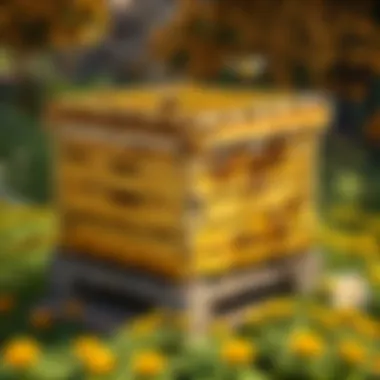Efficient Strategies for Optimizing Beehives to Maximize Honey Collection


Beehive Setup and Management
Optimizing beekeeping endeavors requires meticulous attention to the setup and management of beehives. Proper hive placement, ventilation, and insulation are crucial factors in ensuring the well-being of the bee colony. Strategic positioning of the hive entrance can influence bee traffic flow and ease of honey collection. Additionally, regular inspections and maintenance routines contribute to the overall efficiency and productivity of the hive.
Honey Extraction Techniques
Efficient honey extraction techniques are essential for optimizing the process of collecting honey from beehives. Beekeepers can utilize various methods such as the crush and strain technique, bee escape boards, or centrifugal honey extractors to harvest honey effectively. Each technique has its advantages and suitable applications based on the hive's size, bee population, and honey production levels. Proper handling and storage of extracted honey further contribute to maintaining its quality and flavor.
Hive Productivity Enhancements
Enhancing hive productivity involves implementing strategies to boost honey production and overall hive health. Beekeepers can introduce pollen supplements, sugar syrup feeding, and regular hive inspections to stimulate honey production and ensure the colony's nutritional needs are met. Queen bee maintenance, swarm prevention techniques, and hive expansion considerations also play pivotal roles in maximizing honey yields and sustaining a thriving bee population.
Sustainability Practices in Beekeeping
Incorporating sustainable practices in beekeeping is integral to optimizing beehive functionality and honey collection processes. Utilizing natural pest control methods, promoting biodiversity in bee forage areas, and minimizing hive disturbances contribute to the long-term health and productivity of bee colonies. Employing eco-friendly hive materials, such as non-toxic paints and sustainable beekeeping equipment, aligns with conservation efforts and supports environmental stewardship within the beekeeping community.
Conclusion
By implementing strategic hive management techniques, adopting efficient honey extraction methods, enhancing hive productivity, and prioritizing sustainability practices, beekeepers can optimize their beehives for easy honey collection. The synergy of these elements not only streamlines the beekeeping process but also fosters a harmonious relationship between beekeepers and their resident bee colonies, resulting in a rewarding honey harvesting experience.
Introduction
In the world of beekeeping, optimizing the beehive for easy honey collection is a crucial aspect that can significantly enhance productivity and accessibility for beekeepers. This section will delve into various strategies and techniques aimed at streamlining the honey collection process, ultimately making it more efficient and rewarding. Understanding the intricacies of beehive management plays a pivotal role in ensuring a successful harvest, and this article will address key considerations to achieve optimal results.
Understanding the Honey Collection Process
Role of Bees in Honey Production
Bees, as the primary agents of honey production, play a fundamental role in the overall process. Their exceptional pollination abilities and wax production are essential for creating bee colonies that are efficient in honey making. The unique social structure within a colony ensures division of labor, with each bee having a specific task contributing to honey collection. This specialization results in a streamlined production process, maximizing output. However, bee behavior can also be influenced by external factors, requiring careful management to maintain productivity.
Impact of Beehive Management
Effective beehive management is critical for ensuring a smooth honey collection process. Proper maintenance of hives, regular inspections, and disease control are all aspects that fall under this purview. The way beehives are set up and maintained can directly impact the productivity of the bees. Investing time and effort into managing beehives efficiently can lead to increased honey yields and healthier bee colonies. However, poor hive management practices can result in decreased productivity, bee stress, and other challenges that hinder honey collection.


Significance of Efficient Beehive Management
Benefits of Optimized Honey Collection
Optimizing honey collection brings several advantages to beekeepers. It enhances overall productivity, reduces labor intensity, and allows for a more organized and systematic approach to beekeeping tasks. By streamlining the process, beekeepers can save time and resources while increasing the quality of the honey harvested. Additionally, efficient honey collection methods contribute to the well-being of the bee colonies, ensuring their longevity and productivity.
Challenges Faced by Beekeepers
Despite the benefits, beekeepers encounter various challenges in optimizing honey collection. These include environmental factors, bee diseases, hive maintenance issues, and fluctuating market demands. Balancing these challenges while maintaining bee colonies can be demanding and requires continuous monitoring and adaptation. Overcoming these obstacles is essential for beekeepers to achieve consistent and sustainable honey production levels.
Optimizing Beehive Setup
In the realm of beekeeping, optimizing the beehive setup is a critical factor that can significantly impact honey collection efficiency. By meticulously designing and arranging the beehives, beekeepers can create an environment that is conducive to the well-being of the bees and the smooth extraction of honey. One of the fundamental aspects of optimizing beehive setup is selecting the appropriate type of beehive to suit the specific needs and conditions of the bee colony.
Choosing the Right Beehive Type
When it comes to choosing the right beehive type, beekeepers are faced with a plethora of options, each with its own set of pros and cons. Various beehive styles such as Langstroth, Top-Bar, and Warre have distinct characteristics that cater to different beekeeping goals. Understanding the advantages and disadvantages of each style is crucial in optimizing the honey collection process.
Pros and Cons of Different Beehive Styles
The Langstroth beehive, known for its modular design, provides ease of management and scalability, making it a popular choice among beekeepers. On the other hand, the Top-Bar hive promotes natural comb building and is preferred for its simplicity and low cost. Evaluating these aspects relative to the beekeeping objectives is essential in determining the most suitable beehive style.
Factors to Consider in Selection
In the selection of a beehive type, factors such as climate, bee species, and beekeeper's experience play a vital role. Considering the environmental conditions and bee behavior ensures the optimal functioning of the beehive. Moreover, the beekeeper's familiarity with a particular hive style influences the effectiveness of hive management practices.
Strategic Placement of Beehives
Apart from selecting the right beehive type, strategic placement of beehives is another key consideration in optimizing honey collection. Identifying ideal locations for beehive placement and maximizing sunlight exposure are integral components in ensuring the productivity and health of the bee colonies.
Ideal Locations for Beehive Placement
Choosing the ideal locations for beehive placement involves factors such as proximity to nectar sources, water availability, and protection from harsh elements. Placing beehives in areas with abundant forage leads to increased honey production, benefitting both the bees and the beekeeper.
Optimizing Sunlight Exposure


Optimizing sunlight exposure is crucial for the vitality of bee colonies, as sunlight aids in regulating hive temperature and activity. Positioning beehives in areas that receive adequate sunlight throughout the day fosters optimal hive conditions, promoting bee health and efficient honey production.
Maintaining Beehive Hygiene
Ensuring proper hygiene within the beehives is paramount for sustaining a healthy bee population and high-quality honey production. Emphasizing cleanliness in honey production and implementing stringent hygiene practices are essential steps in optimizing the beekeeping operation.
Importance of Cleanliness in Honey Production
The cleanliness of beehives directly impacts the purity and quality of the harvested honey. Maintaining a hygienic environment within the hive mitigates the risk of contamination and disease, safeguarding the well-being of the bees and the integrity of the honey yield.
Steps for Ensuring Hygienic Conditions
Implementing regular hive inspections, sanitizing hive equipment, and disposing of old comb are practices that contribute to maintaining hygienic conditions. By adhering to hygiene protocols and swiftly addressing any hive irregularities, beekeepers can uphold the sanitary standards necessary for successful honey collection.
Enhancing Honey Collection Techniques
In the realm of beekeeping, optimizing honey collection techniques stands as a pivotal aspect in maximizing productivity and ensuring the well-being of bee colonies. Enhanced honey collection methods contribute significantly to the overall efficiency of beekeeping practices, allowing beekeepers to extract honey with minimal disturbance to the bees and their environment. By implementing strategic approaches to honey collection, beekeepers can streamline their operations and facilitate the extraction process, resulting in higher yields of high-quality honey. Utilizing bee-friendly methods is essential not only for the welfare of the bees but also for sustainable beekeeping practices.
Utilizing Bee-Friendly Methods
Non-Intrusive Approaches to Honey Extraction
Non-intrusive approaches to honey extraction focus on methods that minimize disruptions to the natural behavior of bees during the harvesting process. By employing techniques such as using bee escapes or bee repellents, beekeepers can extract honey without causing undue stress to the colonies. This gentle approach not only safeguards the well-being of the bees but also ensures a smoother extraction process, yielding honey of superior quality. The non-intrusive nature of these methods reduces the risk of defensive behavior from the bees, making the extraction process safer and more efficient for beekeepers.
Minimizing Disturbance to Bee Colonies
Minimizing disturbance to bee colonies is paramount in bee-friendly honey collection practices. By utilizing tools and methods that cause minimal disturbance, beekeepers can maintain the harmony and stability of the bee colony. Techniques such as using smoke or working during favorable times of the day help minimize disruptions to the bees' routine activities, allowing for a peaceful and efficient honey collection process. By prioritizing the well-being of the bee colonies, beekeepers can ensure sustainable beekeeping practices and promote a healthy bee population.
Implementing Efficient Tools and Equipment
Essential Beekeeping Supplies
Essential beekeeping supplies play a crucial role in facilitating efficient honey collection and maintaining bee colonies. From protective gear such as beekeeping suits and gloves to essentials like hive tools and smokers, beekeepers rely on these supplies to carry out tasks effectively. The key characteristic of essential beekeeping supplies lies in their functionality and durability, ensuring that beekeepers can work safely and efficiently in managing their hives. While these supplies are indispensable for beekeeping operations, it is essential for beekeepers to invest in high-quality equipment to optimize honey collection practices.


Modern Innovations for Honey Harvesting
Modern innovations have revolutionized honey harvesting techniques, offering beekeepers advanced tools to enhance efficiency and productivity. Innovations such as automated honey extractors, hive monitoring systems, and digital tools for hive management have streamlined traditional beekeeping practices. The key characteristic of modern innovations lies in their ability to simplify complex tasks and provide beekeepers with real-time insights into hive conditions. While these innovations bring numerous benefits to honey harvesting, beekeepers should carefully assess the advantages and disadvantages of integrating these technologies into their beekeeping practices for optimal results.
Ensuring Beekeeper Safety and Well-Being
In the realm of beekeeping, prioritizing beekeeper safety and well-being is of paramount importance. Beekeepers face various risks and challenges while tending to their hives, making it crucial to implement measures that ensure their protection and health. By emphasizing safety protocols and adopting appropriate practices, beekeepers can safeguard themselves against potential hazards and enjoy a secure beekeeping experience. Ensuring beekeeper safety and well-being not only protects individuals but also contributes to the overall sustainability and success of beekeeping endeavors.
Protective Gear for Honey Collection
Role of Beekeeping Suit and Accessories
When it comes to beekeeping activities, the beekeeping suit and accessories play a pivotal role in ensuring beekeeper safety. The beekeeping suit, typically constructed from a thick protective material, acts as a shield against bee stings, providing a crucial layer of defense for beekeepers. Additionally, accessories like gloves, veils, and hive tools further enhance safety measures, allowing beekeepers to interact with the hive and bees with reduced risk of harm. The key characteristic of the beekeeping suit and accessories lies in their ability to offer comprehensive protection without inhibiting the beekeeper's movements, enabling efficient hive management while minimizing exposure to potential risks.
Minimizing Risk of Bee Stings
Minimizing the risk of bee stings is a critical aspect of beekeeper safety that directly impacts their well-being. By implementing strategies to decrease the likelihood of bee stings, such as wearing appropriate protective gear and maintaining a calm demeanor around the bees, beekeepers can significantly reduce the chances of painful encounters. The practice of gentle hive manipulation and utilizing smoke to calm the bees also serves to mitigate stinging incidents, creating a safer environment for both beekeepers and bees. While bee stings can cause discomfort and allergic reactions in some individuals, proactive measures focused on minimizing risks contribute to a harmonious coexistence between beekeepers and their industrious companions.
Practicing Sustainable Beekeeping
Environmental Considerations in Beekeeping
Integrating environmental considerations into beekeeping practices promotes sustainability and supports the overall health of bee colonies and ecosystems. By choosing beekeeping locations free from harmful chemicals and pesticides, beekeepers can contribute to the preservation of bee habitats and biodiversity. Implementing organic beekeeping methods and fostering natural foraging opportunities for bees are essential environmental considerations that benefit both bees and the surrounding environment. The unique feature of environmental considerations lies in their ability to establish a balanced ecosystem where bees thrive and fulfill their crucial pollination role, ensuring a sustainable future for beekeeping.
Promoting Bee Population Conservation
Promoting bee population conservation is a proactive approach to safeguarding bee species and preserving their invaluable contributions to biodiversity and food production. By supporting initiatives that aim to protect bee populations from decline, beekeepers actively participate in broader conservation efforts that benefit the ecosystem at large. Adopting bee-friendly practices, such as planting pollinator-friendly flowers and creating bee-friendly habitats, enhances bee population conservation and sustains the delicate balance of nature. The promotion of bee population conservation serves as a testament to responsible beekeeping practices and the dedication to preserving these vital pollinators for future generations.
Conclusion
In the realm of beekeeping, the conclusion serves as the culmination of all the efforts and strategies discussed throughout this article on optimizing beehives for easy honey collection. It encapsulates the vital role that efficient beehive management plays in ensuring a streamlined and productive honey collection process. By focusing on aspects such as hive setup, honey extraction techniques, beekeeper safety measures, and sustainable practices, beekeepers can significantly enhance their overall output and minimize challenges. Ultimately, the conclusion emphasizes the importance of embracing innovative approaches and adaptability in modern beekeeping practices to maximize productivity and ensure the well-being of both bees and beekeepers.
Summarizing Key Strategies
Key Takeaways for Efficient Honey Collection
Efficient honey collection hinges on a harmonious blend of strategic hive setup, meticulous hygiene practices, and bee-friendly extraction methods. The key takeaway from this discussion is the paramount significance of optimizing every aspect of beekeeping to streamline honey collection. By carefully selecting beehive types, maintaining hygiene, and utilizing non-intrusive extraction techniques, beekeepers can significantly increase their honey yield while minimizing disruptions to bee colonies. This focus on efficiency not only boosts productivity but also fosters a sustainable and mutually beneficial relationship between beekeepers and bees. Emphasizing these key takeaways in practice can lead to a more productive and fulfilling beekeeping experience, reaping rewards in the form of high-quality honey and thriving bee colonies.
Future Trends in Beekeeping Industry
The future of beekeeping is poised to embrace advanced technology, sustainable practices, and a deeper understanding of bee behavior. One notable trend shaping the industry is the integration of IoT (Internet of Things) solutions to monitor hive health remotely and optimize beekeeping practices. This technological advancement not only enhances efficiency but also empowers beekeepers with real-time insights into hive conditions and potential challenges. Furthermore, a growing emphasis on sustainable beekeeping methods, such as organic hive management and native plant preservation, signifies a shift towards environmentally conscious practices within the industry. Embracing these future trends not only promotes the well-being of bee populations but also ensures the long-term viability of beekeeping as a crucial agricultural practice, safeguarding both bees and the natural ecosystems they support.



